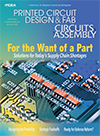Features Articles
 A simpler, smarter way to get stackups right the first time.
A simpler, smarter way to get stackups right the first time.
For years, we talked about “handing off” design data to manufacturing partners. Many still do. The handoff model is simple: design sends “build intent” in one direction, usually through a mix of emails, spreadsheets, PowerPoints and Word documents.
 The switch to renewables is about energy security and climate change.
The switch to renewables is about energy security and climate change.
While climate change is obviously the big-picture issue in the global drive to decarbonize, energy security is an important aspect that is shaping governments’ policies worldwide. From either perspective – strategic or environmental – Europe and the US are far behind China in the race to adopt renewables. China reported installing 198GW of solar capacity between January and May. Effectively, that’s the equivalent of adding 100 panels every second!
 When EMS gets treated like a commodity, quality becomes the hidden surcharge.
When EMS gets treated like a commodity, quality becomes the hidden surcharge.
One trend in the electronics manufacturing services (EMS) industry that I don’t like is the commoditization of services. This isn’t new. It’s been going on for decades, but it has been getting worse. Part of the problem, I think, is that the EMS value proposition has gotten lost. The lengthy period of material constraints and forecast instability changed many business behaviors, not necessarily for the better. Also, purchasing organizations have undergone a generational shift. The result has been several unrealistic expectations that harm the business relationship on both sides.
 Repairing ancient technology has its silver lining.
Repairing ancient technology has its silver lining.
Let it be said that the printed circuit industry faces a whole lot of challenges. While some are geopolitical in nature, most are not. The foundational challenge is advancing technology in the most cost-effective and profitable manner to enable continued development of exciting new processes and products. Successfully meeting these basic challenges has long been the hallmark of our industry.
 A positive counterbalance for mitigating inflation.
A positive counterbalance for mitigating inflation.
Ideally, design for excellence (DFx) should optimize and standardize every product and associated manufacturing processes to achieve high throughput and eliminate defect opportunities. While Lean original equipment manufacturers (OEMs) may reach those lofty goals in their facilities, electronics manufacturing services (EMS) environments rarely achieve them. In these environments, OEMs control their designs and much, if not all, of their approved material list (AML).
 How to limit shared design data, protecting IP and securing the manufacturing handoff.
How to limit shared design data, protecting IP and securing the manufacturing handoff.
Last month’s column on intelligent data transfer discussed how PCB design data have evolved from unintelligent, fragmented formats like Gerber to an intelligent, integrated, single-file exchange through IPC-2581. We talked about what intelligent data means – design data that retains their full context, hierarchy and relationships throughout the product lifecycle – and why the industry needs to move away from legacy Gerber-based packages.
This month, we take a deeper look at how intellectual property (IP) is protected using IPC-2581 and how its function mode capability enables secure and efficient data sharing (Figure 1).


